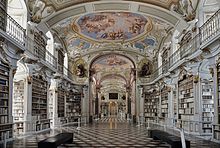Admont Abbey Library
The Abbey Library of Admont Abbey , founded in 1074, was completed in 1776 and is a baroque monastic library wing in Admont in Upper Styria .
architecture
It has been referred to as the eighth wonder of the world in the past. At 70 m in length, 14 m in width and around 13 m in height, it is the world's largest monastic book room. This hall accommodates approx. 70,000 the entire book inventory of the monastery comprises 200,000 volumes.
The architect Josef Hueber (1715 / 7–1787) designed an ingenious threefold structure of the room, vaulted by seven domes. 48 windows in connection with the white and gold bookcases ensure a special brightness; for this reason an artificial light source was never added later.
This concept was based on the Enlightenment : light was equated with knowledge and should flow through the monastery library . The ceiling frescoes by Bartolomeo Altomonte (1694–1783) show the various stages of human knowledge up to divine revelation in the central dome. Below on the shelves are editions of the Bible and the Church Fathers; in the northern part of the hall the theological literature and in the southern wing books of profane sciences.
The sculptural jewelry comes from the sculptor Josef Thaddäus Stammel (1695–1765). The last four things in the middle room stand as a highlight of his work in contrast to the enlightenment concept of the architect and the painter. Created years earlier, these carvings are still unaffected by the Enlightenment.
Manuscripts and incunabula
The Admont Abbey Library contains over 1,400 valuable manuscripts, including more than half from the Middle Ages. The number of incunabula (books printed up to 1500) and early prints (printed works from the period 1501–1520) is over 930.
The oldest collection consists of gifts from the first monks from their mother monastery St. Peter in Salzburg and from the monastery founder Archbishop Gebhard .
During the 12th century, the important scriptorium produced manuscripts both for their own use and for monasteries abroad.
Due to the large number of artistically furnished manuscripts and incunabula ( ornaments , miniatures , woodcuts ), the holdings represent a considerable art collection. In academic terms, the Admonter manuscript and incunabula collection offers a wealth of valuable source material for numerous research areas, such as the Admonter Bartholomäus from the 15th century for medical history.
This collection has been in a specially created security archive since 2000.
Some of these valuable books and manuscripts are exhibited in a separate room in the museum in annually changing exhibitions on a specific topic.
The discovery of two parchment fragments of the Abrogans , which are said to have been made around the year 800, was published in 2017. The fragments were used for a book cover in the 18th century and stored in a folder by restorers in 1963 and may have come from a bookbinder in Steyr or Graz , who probably had them from monasteries such as Mondsee Monastery .
Abbey librarians
The two monastic offices of the monastery librarian and the monastery archivist have been united in one person since the second half of the 20th century.
- P. Jakob Wichner OSB (until 1903)
- P. Friedrich Fiedler OSB (until 1945)
- P. Adalbert Krause OSB (1945–1979)
- P. Bruno Hubl OSB (until 1981) - 1996–2017 Abbot of Admont
- Johann Tomaschek (until 2013)
- P. Maximilian Schiefermüller OSB (since 2014). He is also prior of the Admont Abbey, superior and pastor of the pilgrimage church Frauenberg an der Enns .
Literature and Sources
- Michael Braunsteiner (Ed.): Baroque sculptor Josef Stammel 1695–1765 . Admont 1997.
- Michael Braunsteiner, Gerald Unterberger, P. Winfried Schwab: Klosterführer / Monastery Guide . Admont 2006.
- Johann Tomaschek u. a .: Admont Benedictine Abbey. Sights and collections . Admont 1990.
- Admont Abbey Archives
Web links
- Admont Abbey
- Article by the Federal Monuments Office (BDA) on the Abbey Library (June 2005)
- Entry in the manual of the historical book collections by Bernhard Fabian (Ed.)
Individual evidence
- ↑ Valuable documents discovered in Admont Abbey on orf.at, accessed on May 12, 2017
- ↑ Sensation from the portfolio, Der Spiegel, No. 20, 2017, pp. 104-105
- ↑ Norbert Regitnig-Tillian: word donation. In: profile . ZDB -ID 511897-9 ISSN 1022-2111 . May 15, 2017. Volume 48, No. 20, pp. 86–89.
Coordinates: 47 ° 34 ′ 33 ″ N , 14 ° 27 ′ 38 ″ E








